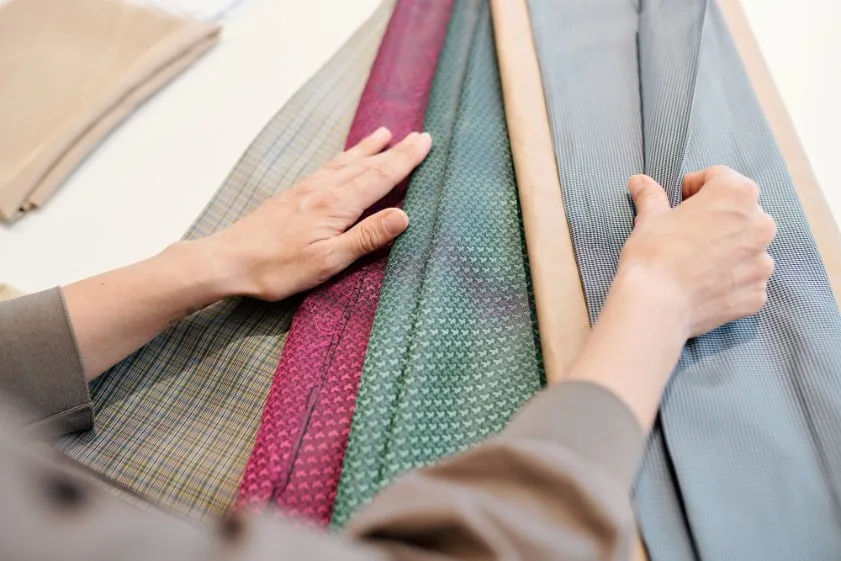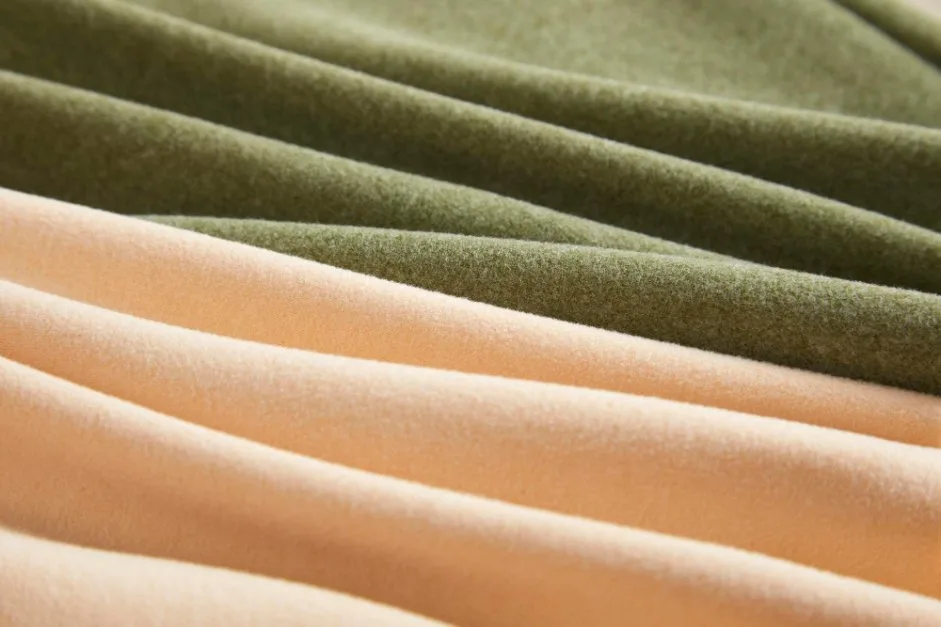Expert-Tested Materials, Scientific Comparisons, and Smart Buying Strategies for Cold Weather Clothing
When winter arrives, choosing the right fabrics becomes crucial for staying comfortable and warm. The materials in your clothing directly determine how well your body retains heat and manages moisture during cold weather conditions. Understanding fabric properties helps you make informed decisions about winter clothing investments.
To help you make the best choices for your specific needs, we’ve created several interactive tools: take our Winter Fabric Selector Quiz to find materials perfect for your climate, use our Winter Wardrobe Cost Calculator to budget your purchases, try our Layer Combination Generator for personalized layering advice, and create a Fabric Care Routine Planner to maintain your investment
Bottom Line: Wool stands out as the warmest natural material, with merino wool and Icelandic varieties offering superior heat retention. Down provides the best warmth-to-weight ratio, while modern synthetic fabrics like fleece deliver reliable performance at lower costs.
Table of Contents
Understanding How Fabrics Keep You Warm
Winter fabric performance depends on several key scientific principles. The most effective materials trap warm air close to your body while allowing moisture to escape. This balance prevents the clammy feeling that can make you feel colder even when wearing thick clothing.
The Science Behind Insulation
Insulation works by creating barriers that slow heat transfer from your warm body to the cold environment. The best insulating fabrics contain tiny air pockets that trap heat. Air itself is an excellent insulator when it’s not moving, which is why fluffy materials like down and fleece perform so well.
Thermal conductivity measures how easily heat passes through a material. Lower numbers mean better insulation. Research shows these thermal conductivity values for common winter fabrics:
| Fabric Type | Thermal Conductivity (W/m·K) | Insulation Rating |
|---|---|---|
| Wool | 0.043-0.046 | Excellent |
| Fleece | Below 0.004 | Excellent |
| Cotton | 0.026-0.065 | Good |
| Down | 0.025 | Excellent |
| Polyester | 0.040-0.050 | Good |
Not sure which fabrics are right for your specific situation? Our Winter Fabric Selector Quiz analyzes your climate, activity level, and preferences to recommend the perfect materials for your needs.
Natural vs Synthetic Materials
Natural fabrics come from animals and plants. Wool leads the pack for winter warmth because its crimped fibers create millions of tiny air pockets. These spaces trap heat while still allowing moisture to move through the fabric. Wool can absorb up to 30% of its weight in moisture while still feeling dry.
Cotton fabric offers comfort but absorbs and holds moisture against your skin. This makes cotton a poor choice for very cold conditions where sweating might occur.
Synthetic materials like polyester are engineered for specific performance characteristics. Modern synthetics can match or exceed natural materials in many areas while offering advantages like faster drying and lower cost.
Moisture Management Properties
Staying dry is just as important as staying warm. When sweat accumulates on your skin, it conducts heat away from your body as it evaporates. The best winter fabrics move moisture away from your skin to the outer surface where it can evaporate harmlessly.
Merino wool excels at moisture wicking while maintaining warmth. Most synthetic fabrics also have excellent moisture-moving properties, with polyester and polypropylene being particularly effective.
What is the Warmest Fabric to Wear in Winter?
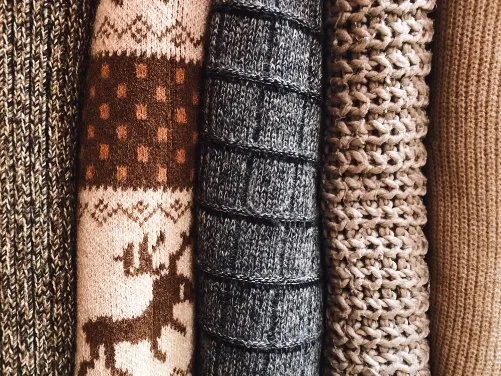
Wool takes the crown as the warmest natural fabric for winter wear. Scientific testing confirms that wool’s unique fiber structure provides superior heat retention compared to other materials. Icelandic wool performs even better than regular wool due to its thickness and natural water resistance.
Premium Wool Varieties
Merino Wool: The finest wool available, merino offers exceptional warmth without the itchiness of regular wool. Its ultra-fine fibers feel soft against skin while providing excellent insulation and moisture management.
Cashmere: Made from Kashmir goat undercoat, cashmere can be seven to eight times warmer than merino wool. However, it’s more delicate and expensive.
Icelandic Wool: These sheep have adapted to harsh climates, producing wool with two layers: a coarse outer layer for weather protection and a soft inner layer for insulation.
Alpaca Wool: Lightweight yet incredibly warm, alpaca fiber is hypoallergenic and naturally water-resistant.
Down: The Ultimate Warmth-to-Weight Champion
Down insulation from geese and ducks provides the highest warmth-to-weight ratio of any natural material. Quality down is measured by fill power, with ratings from 600 to 900. Higher numbers indicate better loft and insulation performance.
Down works by trapping air in its three-dimensional structure. However, it loses insulating properties when wet, making it best for dry cold conditions.
Which Thermal Fabric is Best for Winter?
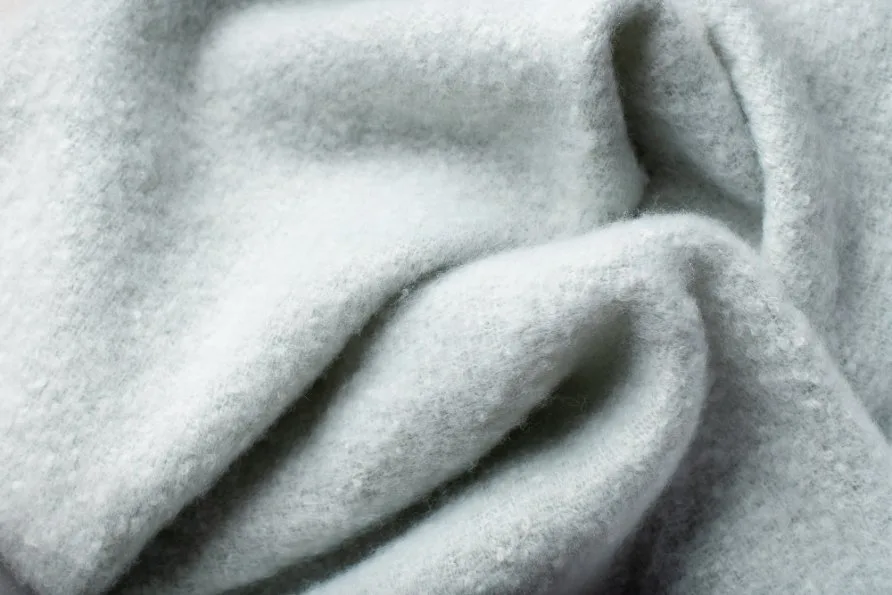
For base layers and thermal underwear, merino wool and synthetic blends offer the best performance. These materials sit closest to your skin and need to wick moisture while providing warmth.
Top Thermal Fabric Options
Merino Wool Thermals: Natural temperature regulation, odor resistance, and comfort make merino ideal for extended wear. It performs well in varying activity levels.
Synthetic Thermal Blends: Materials like polypropylene and polyester thermal fabrics excel at moisture wicking. They dry quickly and maintain insulation when damp.
Silk Base Layers: Surprisingly effective for winter, silk provides excellent insulation despite being thin. It’s naturally hypoallergenic and feels luxurious against skin.
Should Thermals be Cotton or Polyester?
Choose polyester or synthetic blends over cotton for thermal wear. Cotton retains moisture and loses insulating properties when wet. Polyester thermals wick moisture effectively and maintain warmth even when damp.
What Fabric is Best for a Winter Coat?

The best winter coat combines multiple fabric technologies rather than relying on a single material. Modern winter coats use a layered approach:
Outer Shell Materials
Gore-Tex and Technical Fabrics: These water-resistant materials block wind and precipitation while allowing moisture vapor to escape.
Wool Blends: Traditional wool coats offer excellent insulation and wind resistance. Look for tightly woven fabrics with some synthetic content for durability.
Insulation Options
Down Fill: Provides maximum warmth with minimal weight. Choose 650+ fill power for cold weather, 700+ for extreme conditions.
Synthetic Insulation: Materials like Thinsulate and PrimaLoft perform well when wet and cost less than down.
Wool Lining: Adds warmth and moisture management to any coat style.
Best Fabrics for Extreme Winter Conditions

For extreme cold weather, layer systems using wool base layers, synthetic mid-layers, and waterproof outer shells provide the best protection.
Arctic-Tested Materials
Double-Layer Wool: Icelandic and similar wool types with natural dual-layer structure handle extreme conditions better than single-layer fabrics.
Military-Grade Synthetics: Materials developed for military use often exceed civilian fabrics in performance. Look for fabrics tested to specific temperature ratings.
Fur and Faux Fur: Real and synthetic fur provide exceptional warmth by trapping air close to the body. Modern faux fur performs nearly as well as real fur.
The Science of Layering for Maximum Warmth
Layering remains the most effective strategy for winter warmth, allowing precise temperature control while maximizing fabric performance. The three-layer system creates multiple insulation zones while managing moisture transfer from skin to outside air.
How Layering Systems Work
Effective layering creates a microclimate around the body through controlled air spaces and moisture management. Each layer serves a specific function:
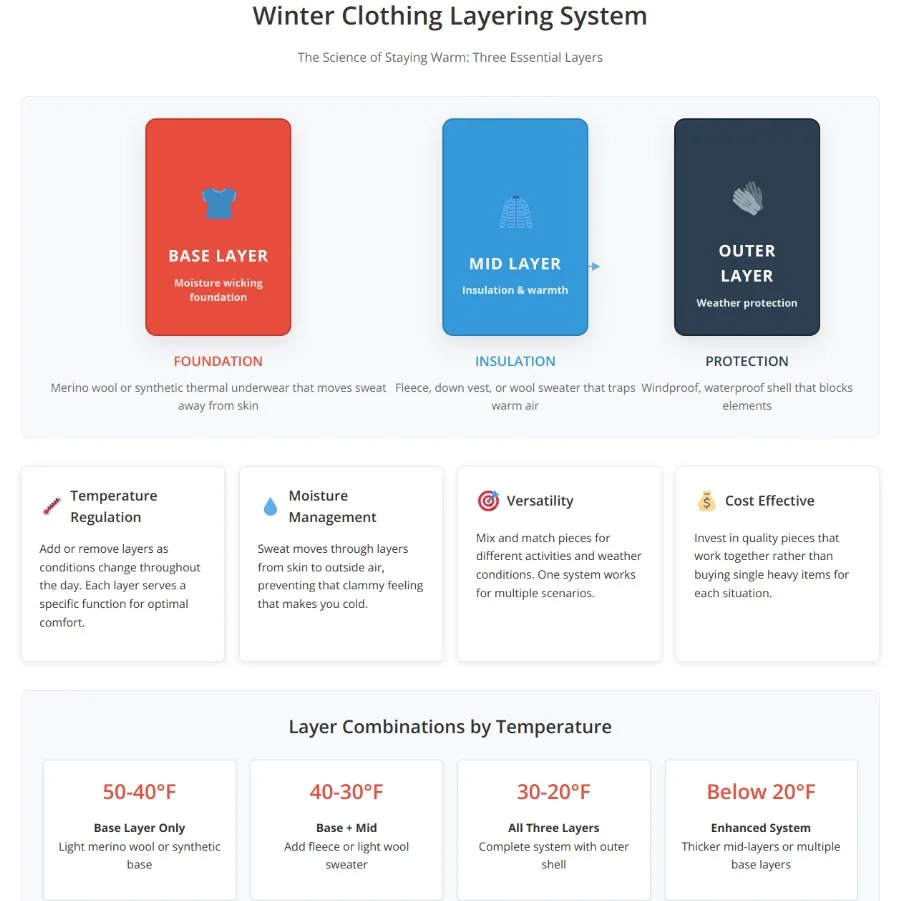
Base Layer Function: Sits directly against skin to wick moisture away from the body. When sweat accumulates on skin, it conducts heat away through evaporation. Quality base layers move this moisture to the next layer while maintaining warmth.
Mid Layer Function: Provides primary insulation by trapping warm air in its structure. This layer should be loose enough to maintain air pockets but fitted enough to work with the base layer’s moisture transfer.
Outer Layer Function: Protects against wind, rain, and snow while allowing moisture vapor to escape. Wind can strip away the warm air trapped in clothing, making windproof outer layers essential for system effectiveness.
Building the Perfect Layer System
Base Layer Selection: Merino wool excels for base layers because it manages moisture while providing insulation even when damp. Synthetic options like polypropylene work well for high-activity situations where moisture production is extreme.
Key base layer characteristics:
- Snug fit without compression
- Moisture-wicking properties
- Odor resistance for extended wear
- Comfort against skin
Mid Layer Options: Fleece provides excellent warmth-to-weight ratio and maintains insulation when damp. Down offers superior warmth but loses effectiveness when wet. Wool sweaters provide versatile insulation with natural temperature regulation.
Effective mid layer features:
- Lightweight but warm construction
- Easy ventilation options (zippers, pockets)
- Compatibility with base and outer layers
- Packability for changing conditions
Outer Shell Requirements: Modern shells balance waterproofing with breathability. Gore-Tex and similar membranes block water while allowing vapor transfer. Uninsulated shells provide maximum versatility for different mid layer combinations.
Essential outer layer elements:
- Wind and water resistance
- Ventilation options (pit zips, mesh panels)
- Adjustable fit at cuffs and hem
- Pocket accessibility with gloves
Temperature-Based Layering Strategies
50-40°F (10-4°C): Light base layer only or base layer with light fleece. Outer shell for wind protection if needed.
40-30°F (4 to -1°C): Base layer plus mid-weight fleece or wool sweater. Light shell for precipitation protection.
30-20°F (-1 to -7°C): Complete three-layer system with insulated mid layer. Consider additional insulation for prolonged exposure.
20-0°F (-7 to -18°C): Enhanced system with heavyweight base layers, thick insulation, and full weather protection. Multiple mid layers may be necessary.
Below 0°F (-18°C): Expedition-weight base layers, high-loft insulation, and specialized outer shells designed for extreme conditions.
Activity-Level Adjustments
Low Activity (Office, Casual): Focus on static warmth with heavier mid layers and wind protection. Natural fibers often provide better comfort for extended wear.
Moderate Activity (Walking, Light Hiking): Balance insulation with ventilation options. Synthetic materials excel at managing varying output levels.
High Activity (Running, Intensive Work): Prioritize moisture management over static warmth. Lightweight, highly breathable layers prevent overheating.
Common Layering Mistakes
Cotton Base Layers: Cotton absorbs and retains moisture, leading to heat loss through evaporation. This creates the dangerous combination of wet and cold.
Overdressing: Too many layers or overly warm layers lead to overheating and excessive sweating, overwhelming the system’s moisture management capacity.
Poor Fit: Layers that are too tight restrict air flow and compress insulation. Layers that are too loose allow warm air to escape and cold air to enter.
Ignoring Extremities: Hands, feet, and head lose significant heat. Quality gloves, socks, and hats are essential components of any layering system.
Advanced Layering Techniques
Zone-Based Layering: Different body areas have varying warmth and moisture production needs. Core layers may differ from arm or leg layers for optimal comfort.
Convertible Systems: Clothing with removable sleeves, zip-off sections, or reversible features allows one garment to serve multiple layering functions.
Vapor Barrier Systems: For extreme conditions, thin vapor barriers between base and mid layers can prevent moisture loss while maintaining core temperature.
Creating the perfect layer combination can be complex with so many variables to consider. Our Layer Combination Generator takes the guesswork out by providing personalized layering recommendations based on your exact temperature, activity level, and weather conditions.
Cashmere vs Wool: Which is Warmer?
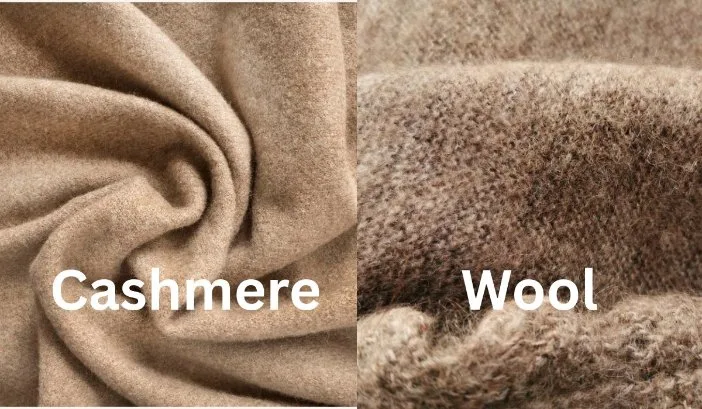
Cashmere is significantly warmer than regular wool, offering 7-8 times more warmth per weight. However, this comparison needs context:
Warmth Comparison
- Cashmere: Exceptional warmth, ultra-soft, lightweight
- Merino Wool: Very warm, more durable, easier care
- Regular Wool: Good warmth, most affordable, very durable
Practical Considerations
Cashmere requires delicate care and costs significantly more than wool. For active winter use, merino wool often provides better value due to its durability and performance characteristics.
Synthetic Fabrics for Winter: Polyester vs Wool
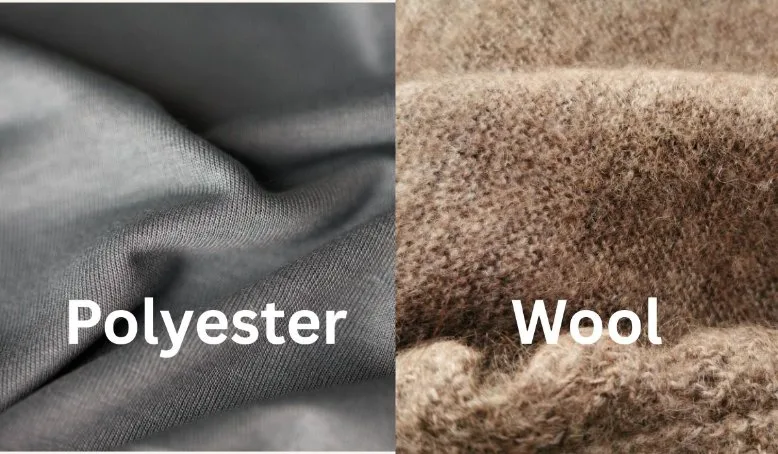
Both polyester and wool have advantages for cold weather, with the best choice depending on your specific needs.
Polyester Advantages
- Quick drying
- Retains insulation when wet
- Lower cost
- Easy care
- Durable
Wool Advantages
- Better temperature regulation
- Natural odor resistance
- Comfortable in varying conditions
- Renewable and biodegradable
The Verdict
For active winter sports, synthetic fabrics often perform better. For everyday winter wear, wool provides superior comfort and versatility.
Fleece Performance: Types and Comparisons
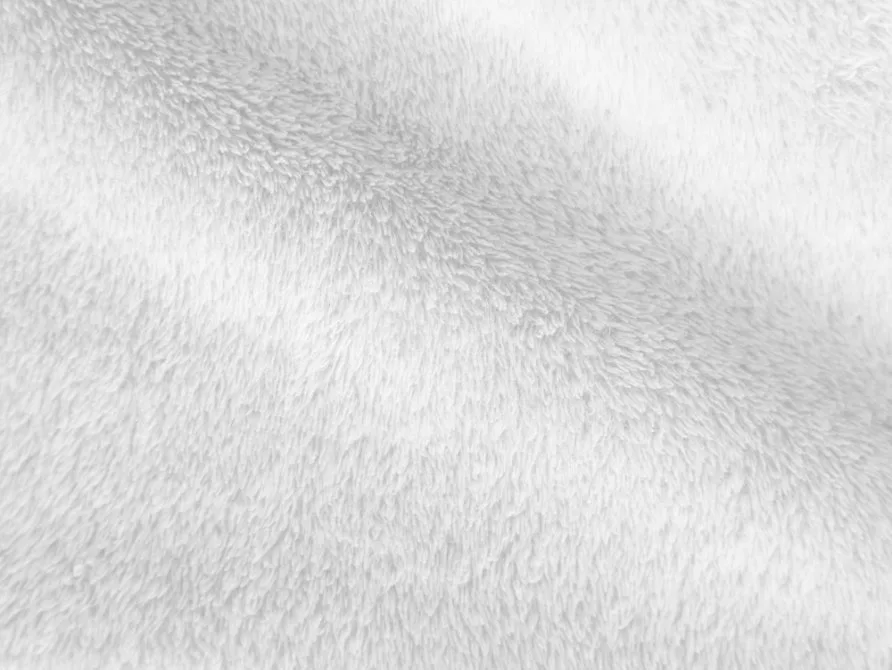
Polar fleece offers excellent warmth-to-weight ratio and remains one of the most popular synthetic insulation materials.
Fleece vs Other Materials
Is Polar Fleece Warmer than Wool? Fleece provides good insulation but generally doesn’t match high-quality wool for warmth. However, fleece excels in moisture management and drying speed.
Thermal vs Fleece Performance Thermal fabrics designed for base layers typically outperform fleece when worn close to the skin. Fleece works best as a mid-layer.
Types of Fleece
Micro Fleece: Lightweight, good for layering Polar Fleece: Standard weight, versatile Thermal Fleece: Heavier weight, maximum warmth
Disadvantages of Polar Fleece
- Can pill with heavy use
- Retains odors more than natural fibers
- Not windproof without additional treatment
- Static electricity buildup
Complete Winter Fabric Buying Guide

Understanding fabric performance is only part of the equation. Smart winter clothing purchases require considering cost, durability, and specific use cases.
Price Ranges by Fabric Type
| Fabric Category | Budget Range | Mid-Range | Premium |
|---|---|---|---|
| Wool Sweaters | $30-60 | $60-150 | $150-400+ |
| Down Jackets | $50-100 | $100-300 | $300-800+ |
| Fleece Items | $20-40 | $40-80 | $80-150+ |
| Base Layers | $15-35 | $35-80 | $80-200+ |
Planning your winter wardrobe budget? Our Winter Wardrobe Cost Calculator helps you estimate costs for essential items and provides money-saving tips based on your budget level and needs.
Quality Indicators to Look For
Wool Products:
- Fiber content percentage
- Yarn weight and twist
- Fabric density
- Country of origin
Down Items:
- Fill power rating (650+ recommended)
- Down-to-feather ratio
- Shell fabric quality
- Construction method (baffle vs sewn-through)
Synthetic Insulation:
- Brand reputation (Thinsulate, PrimaLoft, etc.)
- Weight-to-warmth specifications
- Moisture resistance ratings
- Durability testing results
Where to Shop for Winter Fabrics
Premium Options:
- Specialty outdoor retailers
- High-end department stores
- Direct from manufacturers
Mid-Range Choices:
- National sporting goods chains
- Online retailers with good return policies
- Factory outlet stores
Budget-Friendly Sources:
- Discount department stores
- End-of-season sales
- Second-hand and consignment shops
Seasonal Shopping Strategy
Best Times to Buy:
- End of winter (February-March): Up to 70% off
- Early fall (September): New styles, full selection
- Black Friday/Cyber Monday: 20-40% discounts
Advanced Winter Fabric Technologies
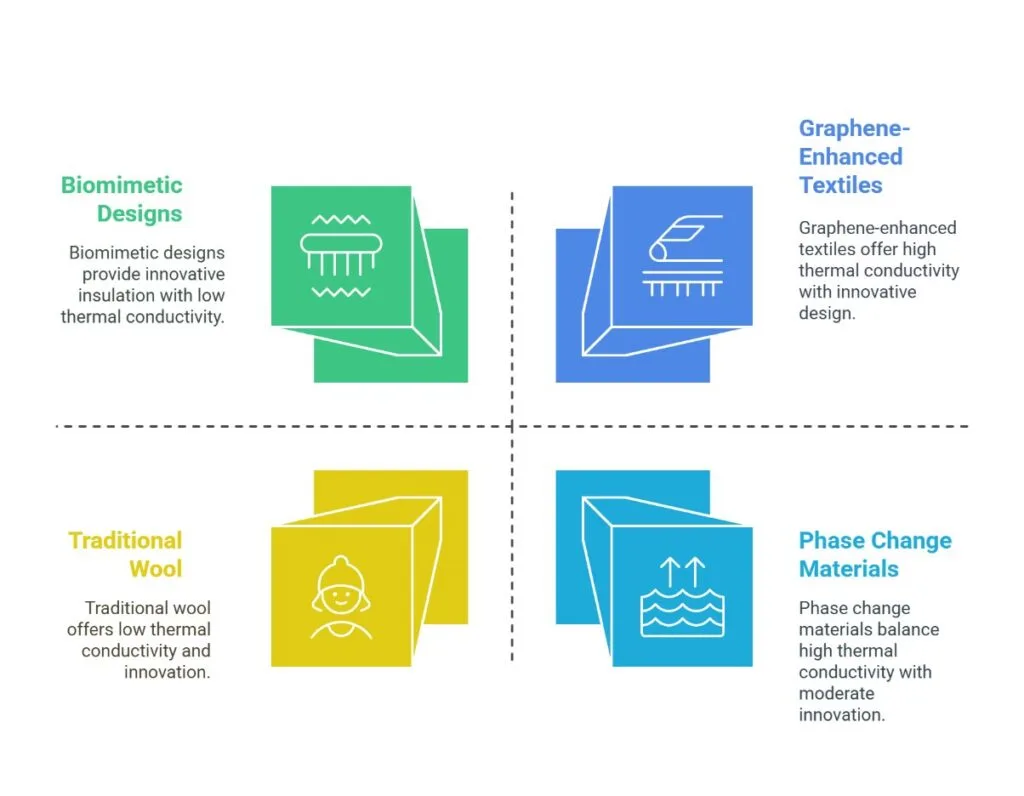
Modern textile science continues pushing the boundaries of winter fabric performance. Understanding these innovations helps you choose cutting-edge materials.
Phase Change Materials (PCMs)
These smart fabrics absorb and release heat as temperatures change, maintaining consistent body temperature. PCM fabrics work well for varying activity levels.
Graphene-Enhanced Textiles
Graphene additions to traditional fabrics can increase thermal conductivity by 100 times while maintaining fabric flexibility. These materials are entering mainstream winter clothing.
Biomimetic Designs
Fabrics inspired by polar animal fur create superior insulation through micro-structure design. Examples include fabrics mimicking polar bear hair or penguin feathers.
Fabric Care for Maximum Performance
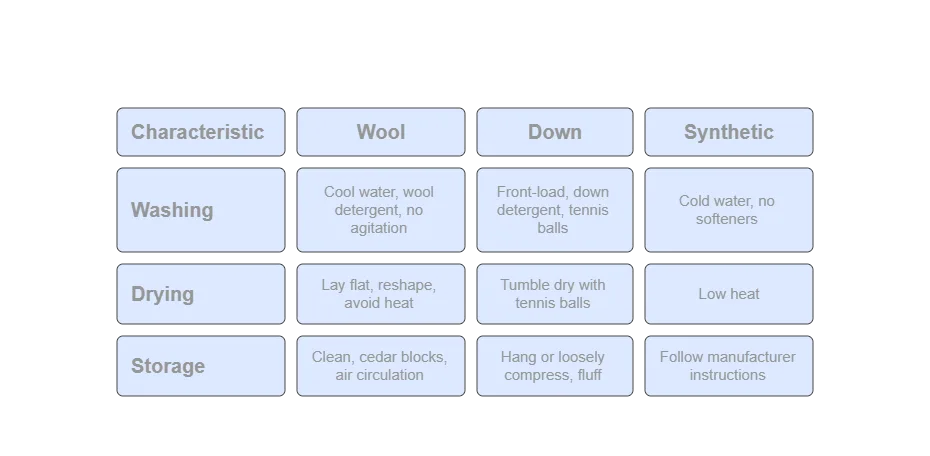
Proper care extends fabric life and maintains insulating properties. Different materials require specific approaches.
Managing care schedules for multiple fabric types can be challenging. Our Fabric Care Routine Planner creates a personalized maintenance schedule based on your specific winter wardrobe, organizing care tasks by frequency and providing timely reminders.
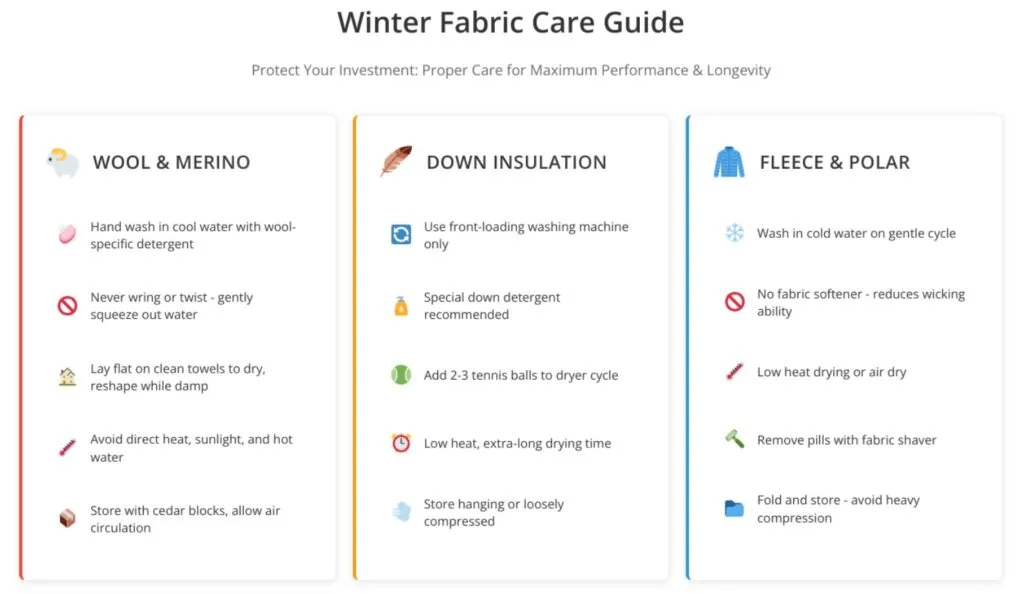
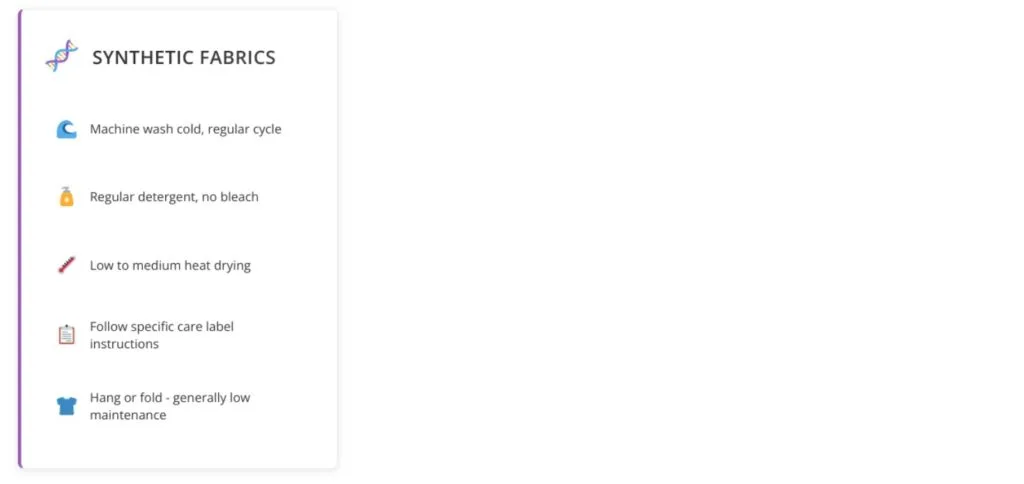
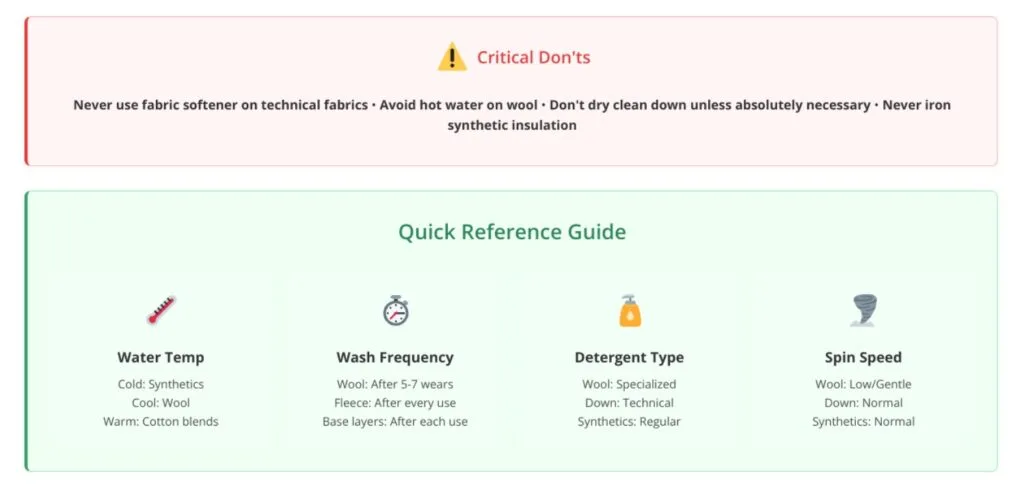

Wool Care Essentials
Proper wool care maintains its insulating properties:
Washing:
- Use cool water and wool-specific detergent
- Avoid agitation and wringing
- Hand washing preferred for delicate items
Drying:
- Lay flat on clean towels
- Reshape while damp
- Avoid direct heat and sunlight
Storage:
- Clean before storing
- Use cedar blocks for moth protection
- Allow air circulation
Down Item Maintenance
Washing Down:
- Use front-loading machines only
- Special down detergent recommended
- Add tennis balls during drying cycle
Storage:
- Hang or store loosely compressed
- Avoid long-term compression
- Occasional fluffing maintains loft
Synthetic Fabric Care
Synthetic fabric care is generally easier:
General Rules:
- Wash in cold water
- Avoid fabric softeners (reduces wicking)
- Low heat drying
- Follow manufacturer instructions
Health and Safety Considerations
Winter fabric choices can affect health and comfort beyond just warmth. Consider these factors when selecting materials.
Allergy and Sensitivity Issues
Wool Allergies: Some people react to lanolin or coarse wool fibers. Merino wool and wool alternatives work better for sensitive individuals.
Synthetic Sensitivities: Some synthetic fabrics can cause skin irritation or trap bacteria. Natural antimicrobial properties in wool often work better for extended wear.
Fire Safety
Natural fibers generally have better fire resistance than synthetic materials. Wool is naturally flame-resistant, while some synthetics can melt and stick to skin.
Chemical Treatments
Look for fabrics with minimal chemical treatments, especially for items worn close to skin. Organic and naturally processed materials reduce exposure to potentially harmful chemicals.
Regional Climate Considerations
Your local climate significantly affects optimal fabric choices. Different winter conditions require different approaches.
Dry Cold Climates
Best Fabrics:
- Down insulation (performs well without moisture)
- Wool outer layers (breathable, warm)
- Cotton blend base layers acceptable
Avoid:
- Heavy moisture-wicking systems (unnecessary)
- Waterproof shells (can cause overheating)
Wet, Humid Cold
Best Fabrics:
- Synthetic insulation (maintains warmth when wet)
- Moisture-wicking base layers essential
- Waterproof outer shells necessary
Avoid:
- Down insulation (loses effectiveness when wet)
- Cotton anything (retains moisture)
Windy Conditions
Essential Features:
- Tightly woven outer fabrics
- Wind-resistant treatments
- Proper fit to prevent air gaps
High Altitude Considerations
Extreme altitude requires specialized fabric choices due to increased UV exposure and temperature swings.
Activity-Specific Fabric Recommendations
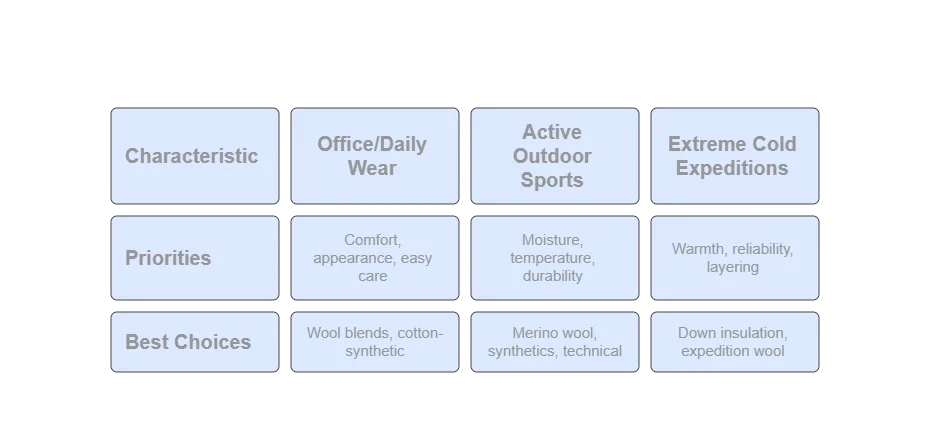
Different winter activities place varying demands on fabric performance. Match your fabric choices to your planned activities.
Office and Daily Wear
Priorities:
- Comfort throughout the day
- Professional appearance
- Easy care
Best Choices:
- Wool blend sweaters
- Cotton-synthetic base layers
- Traditional wool coats
Active Outdoor Sports
Priorities:
- Moisture management
- Temperature regulation
- Durability
Best Choices:
- Merino wool base layers
- Synthetic mid-layers
- Technical outer shells
Extreme Cold Expeditions
Priorities:
- Maximum warmth
- Reliability
- Layering flexibility
Best Choices:
- High-loft down insulation
- Expedition-weight wool
- Military-spec synthetics
Sustainable and Eco-Friendly Winter Fabrics

Environmental consciousness increasingly influences fabric choices. Several sustainable options provide excellent winter performance.
Organic Natural Fibers
Organic Wool: Produced without chemical treatments, organic wool maintains natural properties while reducing environmental impact.
Recycled Down: Reclaimed from used products, recycled down performs similarly to new down while reducing waste.
Plant-Based Alternatives
Tencel and Modal: Made from sustainably harvested wood pulp, these fibers offer wool-like properties with lower environmental impact.
Bamboo Fabric: Fast-growing bamboo creates soft, moisture-wicking fabrics suitable for base layers.
Recycled Synthetic Materials
Recycled Polyester: Made from plastic bottles and textile waste, recycled polyester performs identically to virgin material while reducing pollution.
Recycled Wool: Reclaimed from existing garments, recycled wool maintains most properties of new wool at lower environmental cost.
Frequently Asked Questions
What is the warmest fleece you can buy?
High-loft polar fleece rated at 300+ weight provides maximum warmth in synthetic fleece. Brands like Polartec offer expedition-weight fleece designed for extreme conditions. However, even the warmest fleece typically doesn’t match premium down or wool for pure insulation value.
Is anything warmer than wool?
Down insulation and premium cashmere both offer better warmth-to-weight ratios than regular wool. However, for practical everyday use, high-quality wool remains among the warmest and most versatile options available.
What’s the warmest material for a jacket?
Down insulation with 700+ fill power provides the warmest jacket filling available. Combined with windproof shells and proper construction, down jackets can handle temperatures well below freezing while remaining lightweight.
Which is warmer: puffer coat or wool coat?
High-quality down puffer coats typically provide more warmth than wool coats of similar weight. However, wool coats offer better wind resistance and maintain insulation when damp. For extreme cold, down wins; for versatile winter use, wool often performs better.
Is silk warmer than wool?
Silk provides good insulation for its weight but generally doesn’t match wool’s warming capacity. Silk excels as a base layer due to its smooth texture and moisture-wicking properties, while wool works better for outer insulation layers.
What are the warmest clothes to wear in winter?
The warmest winter clothing systems combine multiple layers: merino wool base layers, down or wool insulation layers, and windproof/waterproof outer shells. This system allows adjustment for varying conditions while maximizing warmth retention.
What fabric keeps cold out best?
Tightly woven wool and synthetic fabrics with durable water repellent (DWR) coatings provide the best cold protection. The key is blocking wind while maintaining breathability to prevent moisture buildup.
What are the best clothes for extreme cold weather?
Extreme cold requires layered systems with expedition-weight base layers, high-loft insulation (down or synthetic), and weatherproof outer shells. Military-surplus and mountaineering-grade equipment often provides the best performance for true extreme conditions.
What is a really good winter coat?
A quality winter coat combines effective insulation (down or premium synthetic), weather-resistant outer fabric, thoughtful design features (adjustable hood, secure pockets, ventilation options), and construction quality that withstands heavy use.
What fabric to use for a puffer jacket?
Puffer jackets typically use lightweight, tightly woven nylon or polyester shells filled with down or synthetic insulation. The shell fabric should be windproof and water-resistant while allowing the insulation to maintain loft.
What is the warmest fleece fabric?
Expedition-weight polar fleece (300+ gram weight) provides maximum synthetic warmth. Brands like Polartec and Patagonia produce high-performance fleece suitable for mountaineering and arctic conditions.
How do I choose the right fabrics for my specific situation?
The best fabric choices depend on your local climate, activity level, budget, and personal preferences. Rather than guessing, use our interactive tools to get personalized recommendations:
• Winter Fabric Selector Quiz – Get fabric recommendations based on your specific conditions
• Layer Combination Generator – Build the perfect layering system for any weather
• Winter Wardrobe Cost Calculator – Budget your winter clothing purchases
• Fabric Care Routine Planner – Maintain your winter clothes properly
Conclusion
Selecting the right winter fabrics involves balancing warmth, performance, durability, and cost considerations. The best approach combines understanding fabric science with practical assessment of your specific needs and conditions.
Key Takeaways for Winter Fabric Selection:
For Maximum Warmth: Wool and down remain the gold standards, with merino wool offering the best balance of performance and practicality. Icelandic wool and premium cashmere provide superior warmth for extreme conditions.
For Active Use: Synthetic materials like polyester fleece and advanced thermal fabrics excel in moisture management and durability. Layer systems work better than single heavy items.
For Versatility: Merino wool stands out as the most adaptable material, performing well across temperature ranges and activity levels while requiring minimal special care.
For Budget Consciousness: Mid-weight fleece and wool blends provide excellent value, offering good performance at reasonable prices. End-of-season sales can make premium materials affordable.
For Sustainability: Organic wool, recycled down, and plant-based synthetic alternatives offer environmentally responsible choices without sacrificing performance.
Investment Strategy: Focus spending on items worn closest to skin (base layers) and outermost protection (shells). These pieces have the greatest impact on comfort and safety.
Care and Maintenance: Proper fabric care significantly extends garment life and maintains performance. Understanding each material’s requirements protects your investment.
The winter fabric landscape continues evolving with new technologies and sustainable options. However, time-tested materials like wool and down remain foundation choices for cold weather protection. Smart shoppers combine these proven performers with modern synthetic materials to create comprehensive winter wardrobes suited to their specific needs and budgets.
Remember that the warmest, most expensive fabric won’t help if it doesn’t match your intended use. A construction worker needs different fabrics than an office worker, and weekend hikers have different requirements than daily commuters. Match your fabric choices to your lifestyle for the best results.
To put this knowledge into practice, explore our interactive tools designed to personalize your winter fabric choices. Whether you need help selecting materials with our Winter Fabric Selector Quiz, planning your budget with our Winter Wardrobe Cost Calculator, creating layer combinations with our Layer Combination Generator, or maintaining your investment with our Fabric Care Routine Planner, these tools make winter clothing decisions simple and effective.
Most importantly, quality matters more than quantity when building a winter wardrobe. Three well-chosen, properly maintained pieces will outperform a closet full of poor-quality items. Invest in understanding fabric types and their properties, then choose accordingly for years of comfortable winter weather protection.


